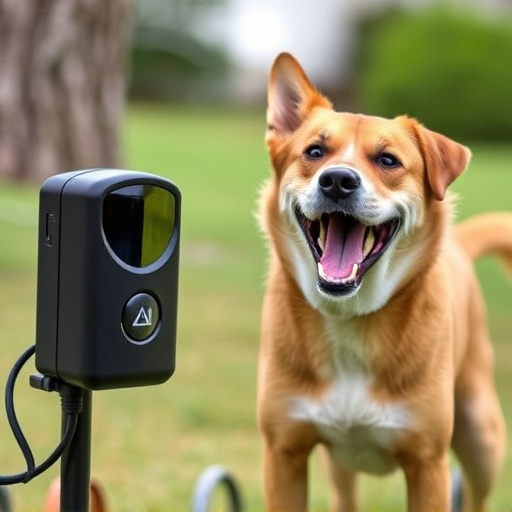Handheld sonic dog deterrents, emitting ultrasonic sounds inaudible to humans (25-64 kHz), offer a humane and popular solution for modifying canine behavior. Effective against barking, jumping, and aggression, these devices work through positive reinforcement and sensory disruption. Their high effectiveness, when used consistently with training, enables pets and owners to enjoy a calmer lifestyle. However, their success varies based on breed, sound sensitivity, and training methods; user feedback is mixed, with some reporting significant improvements while others find limited success. A balanced assessment incorporating both empirical data and user experiences is crucial for evaluating the overall performance of these deterrents.
“Unleashing Positive Change: Exploring Handheld Ultrasonic Systems for Canine Behavior Modification
Dog owners often face challenges with unwanted behaviors, prompting the search for effective training solutions. This article delves into innovative approaches using handheld sonic dog deterrents as an alternative to traditional methods. We explore canine behavior patterns and the limitations of conventional deterrents. Subsequently, we introduce ultrasonic systems, unraveling their science and effectiveness. By examining user feedback, this comprehensive guide aims to shed light on the potential of handheld sonic deterrents as a safe and efficient tool for enhancing canine training.”
- Understanding Canine Behavior and Traditional Deterrents
- Introduction to Ultrasonic Systems for Dog Training
- The Science Behind Handheld Sonic Dog Deterrents
- Evaluating Effectiveness and User Feedback on Sonic Dog Deterrents
Understanding Canine Behavior and Traditional Deterrents
Canine behavior is a complex and fascinating subject, offering insights into the way our furry friends interact with their environment. Dogs have evolved to be highly social creatures, relying on communication for survival, whether it’s through body language or vocalizations. Understanding these behaviors is key to effective training and modification. One specific behavior, barking, can often become problematic for pet owners. Traditional deterrents like spray or shock collars have been used but come with their own set of concerns, including potential harm to the dog’s well-being and lack of addressing the underlying cause.
In recent years, a more humane alternative has gained attention: handheld sonic dog deterrents. These devices emit high-frequency ultrasonic sounds that are inaudible to humans but can effectively disrupt a dog’s barking pattern. The effectiveness of this method lies in its ability to target specific behaviors without causing physical harm, making it a popular choice for responsible pet ownership and training methods.
Introduction to Ultrasonic Systems for Dog Training
Ultrasonic systems have emerged as innovative tools in canine behavior modification, offering a non-violent and effective approach to training. These devices emit high-frequency sound waves that are invisible to the human ear but can be detected by dogs, providing a gentle yet powerful method of communication. The handheld sonic dog deterrents are particularly useful for addressing specific behaviors like barking, jumping, or pulling on leashes.
The effectiveness of these systems lies in their ability to create an immediate and consistent response from dogs. When activated, the ultrasonic sound stimulates the dog’s hearing without causing harm, delivering a subtle but clear signal that reinforces desired behavior changes. This technology has proven successful for various dog training scenarios, offering pet owners and professionals a valuable addition to their behavioral modification arsenal.
The Science Behind Handheld Sonic Dog Deterrents
Handheld sonic dog deterrents have gained popularity as a humane and effective way to modify canine behavior. These devices emit ultrasonic sounds, typically in the 25-64 kHz range, which are inaudible to humans but can be detected by dogs. The science behind their effectiveness lies in the principle of positive reinforcement and sensory disruption. When a dog hears the high-frequency sound, it may experience mild discomfort or disorientation, prompting them to avoid the trigger. Over time, this behavior modification technique teaches the dog to stay away from specific areas or stop engaging in unwanted behaviors.
Research has shown that handheld sonic dog deterrents can be highly effective, especially for issues like barking, jumping, and aggression. The key to their success lies in consistent and targeted use. By combining the deterrent with positive reinforcement training, owners can help their dogs associate certain environments or actions with an unpleasant (but not harmful) sensation, leading to better behavior and a calmer lifestyle for both the pet and the owner.
Evaluating Effectiveness and User Feedback on Sonic Dog Deterrents
Evaluating the effectiveness of handheld sonic dog deterrents is crucial in understanding their impact on canine behavior modification. These devices emit high-frequency sounds that are typically inaudible to humans but can startle and discourage unwanted behaviors in dogs. Studies have shown mixed results, with some users reporting significant improvements in aggression and barking episodes, while others find limited success. The effectiveness often depends on factors such as the dog’s breed, sensitivity to sound, and the consistency of training methods.
User feedback plays a significant role in gauging the overall performance of these deterrents. Many pet owners appreciate the non-confrontational approach these devices offer, especially for addressing minor behavioral issues. However, some critics argue that they may not address the root cause of problematic behavior and could even perpetuate stress or anxiety in dogs if misused. Therefore, it’s essential to consider both empirical evidence and user testimonials when evaluating handheld sonic dog deterrents for their effectiveness as a behavior modification tool.
Ultrasonic systems, particularly handheld sonic dog deterrents, offer a modern approach to canine behavior modification. By understanding canine behavior and leveraging scientific principles, these devices prove effective in addressing various training challenges. User feedback highlights their convenience and success in curbing unwanted behaviors without resorting to traditional, often harsher methods. As pet owners seek more humane solutions, handheld sonic deterrents emerge as a promising game-changer, ensuring a quieter and harmonier coexistence with our four-legged friends.
